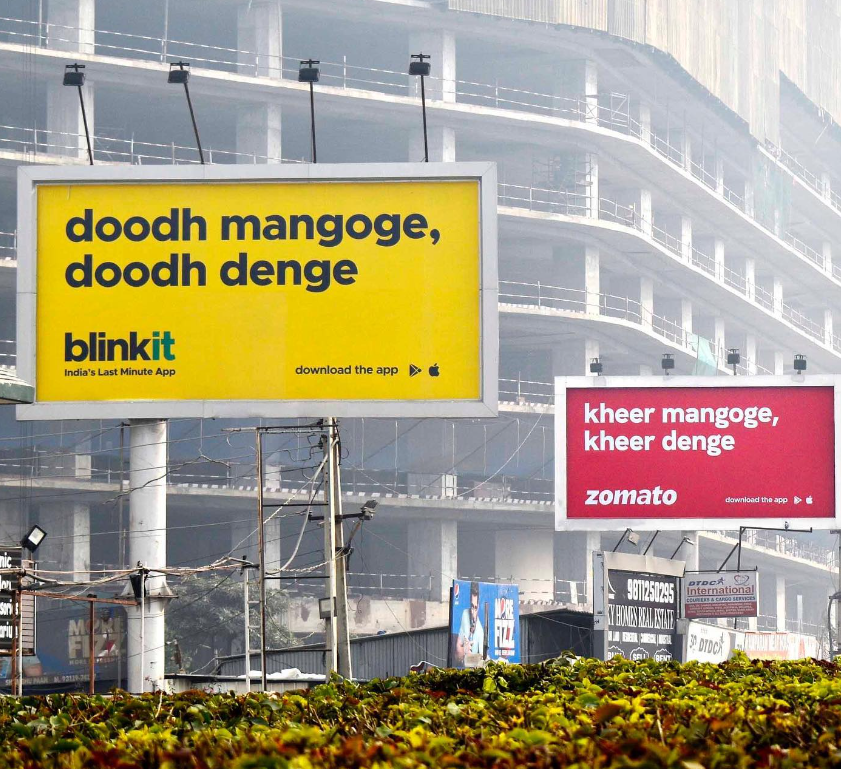How often have you avoided getting off your cosy bed to make yourself a meal? You probably called it a day, and Zomato-ed your way out. Zomato has taken the foodie world by storm with its innovative marketing strategy that satisfies appetite and serves up trends!
In FY 2016-21, Zomato grew at a 62% revenue CAGR each year. That’s a high growth, considering its foundation in 2008. With such growth prospects, Zomato marketing strategy has left its competitors shaken. Let’s explore the trend-setting world of Zomato.
Table of Contents
The Emergence of Zomato and Its Growth Trajectory
Deepinder Goyal and Pankaj Chaddah started Zomato in 2008, and it immediately changed the food-tech business. Zomato started as an online site for finding restaurants, but it quickly grew to include food delivery and table bookings. The platform’s easy-to-use interface, an extensive collection of restaurants, and real-time reviews changed how people found and tried restaurants.
Over the years, Zomato has done nothing but amazing things. By taking advantage of the growing trend of online food ordering and delivery, the site gained a lot of new users and made a lot more money.
Today, Zomato is a major player in the food-tech business, constantly changing to meet customers’ needs and market trends. Its growth from a small startup to a worldwide phenomenon shows that it is determined, has a clear vision, and works hard to change how we find, buy, and enjoy food.
Overview of Zomato Marketing Strategy and Its Importance
Zomato’s colossal success is primarily due to how well it markets itself. In the food delivery and restaurant-finding industry, which is very competitive, Zomato sticks to the following rules: providing a smooth user experience, making sure there are a lot of dining choices, and getting people interested in new campaigns.
Zomato’s marketing efforts are often creative and funny. They use current trends to get the attention of the people they want to reach. Also, the company has used partnerships, discounts, and loyalty programs to keep and get new customers, increasing customer value over their careers.
Top 7 trends that Zomato has started
Embracing the digital age, Zomato effortlessly integrated user-friendly mobile apps, cutting-edge tracking systems, and diverse payment options to offer unparalleled convenience at users’ fingertips.
But wait, there’s more! The various trends initiated by Zomato have revolutionised the dining experience and carved out its position as a leading global firm in the food-tech industry.
Each trend we uncover showcases Zomato’s innovative spirit and ability to predict and adapt to the ever-changing demand in the world of food delivery.
1. Influencer Marketing Strategy by Zomato
Zomato is an expert in influencer marketing because it collaborates with macro and micro-influencers to reach more people through humor, localized content, and memes. Successfully promoting the ongoing Gold Dining Carnival, Zomato and advertising firm Sociowash launched an influencer video-led campaign.
Zomato Gold’s advantages were deliberately highlighted in the 22nd of April campaign by addressing customer pain points like waiting in line, high restaurant expenses, and a lack of available seating.
Famous people, including Jim Sarbh, Mallika Dua, Gagan Arora, Mithila Palkar, Ankush Bahuguna, Danish Sait, and Ahliya, were recruited to spread awareness and encourage participation in the campaign.
2. Zomato Collaboration Strategy
Zomato’s marketing approach is working with influential people and making content people want to read. In videos and other material, they show influencers trying new foods and discussing their restaurant experiences.
Under the name “Zomato Originals,” the team makes content about a wide range of themes. This helps them reach and appeal to more people. This collaboration strategy builds Zomato’s brand and encourages users to place more orders through the Zomato app, which increases total income.
Soham, a famous food blogger in Kolkata with over 101K Instagram followers, started posting food reviews on Zomato while studying law at Heritage Law School. After publishing over 100 reviews, restaurants contacted him for food reviews, leading him to pursue food blogging full-time.
Zomato also partnered with Blinkit, another popular food delivery app that became an internet sensation overnight.
3. Digital Marketing Strategy
Zomato’s digital marketing plan incorporates many tactics, such as SEO and an all-encompassing digital strategy.
Zomato relies heavily on search engine optimization for its advertising. Zomato facilitates customers’ ability to locate restaurants and meal options via web and mobile app searches by optimizing content using keywords, restaurant names, and location data. In India alone, it receives 20.5 M organic pageviews every month.
To efficiently reach potential customers, Zomato uses targeted advertising via platforms like Google Ads and social network ads. Because of this, Zomato uses various digital marketing strategies to keep its name out there. It’s a big reason why the business is expanding and making money.
4. Retention Marketing Strategy
Zomato’s clever and personalized push alerts are integral to its retention marketing strategy. Zomato’s notifications are tailored to each user rather than blanket announcements, making them feel special. These alerts aren’t just meant to inform; they’re meant to amuse and captivate you.
Zomato makes its communications fun and engaging by using humor, puns, and memorable words. Zomato makes its notifications stand out from the crowd by including amusing food-related jokes, mouthwatering cuisine descriptions, and clever reminders to treat oneself.
Zomato also appreciates the value of punctuality. Their method of alerting is not haphazard but rather timely and situationally appropriate. In inclement weather, Zomato may advise a warm and inviting café or send a polite reminder about a lunchtime restaurant special in the area. Zomato creates an emotional bond with its consumers by tailoring its communications to their habits and tastes.
5. Social Media Strategy
The marketing strategy for Zomato’s animal memes has become a standout in the industry. It uses the power of funny and relatable memes to get millennials and Gen Z to pay attention. Zomato connects with its audience better by using humor and things people can relate to.
Memes are easy to share, which helps Zomato’s business because users are eager to send their funny content to their friends.
Memes also leave a lasting impact, making it easier for people to remember and be loyal to a brand. They do this better than traditional commercials. Through this creative strategy, Zomato can reach and keep a tech-savvy audience, strengthening its position as a food delivery leader and finding restaurants.
6. Youtube Marketing
Zomato’s marketing strategy is distinct and exciting since it uses YouTube’s powerful tools to help the company become a famous content maker.
One such instance is Zomato’s “Table for Two” YouTube series. Bollywood actors and other celebrities promote their forthcoming projects while enjoying a meal hosted by Zomato brand manager and influencer Sahiba Bali. Zomato gets more eyeballs on its material by leveraging famous people’s fame and fan bases.
Another good illustration is the “Sunday Brunch” video series produced by Zomato and Curly Tales and starring YouTuber and social media influencer Kamiya Jani. Continuing the viewer’s immersion in food and travel, this series thoroughly investigates brunch locations and culinary experiences. Zomato finds the sweet spot between food and entertainment, keeping its audience returning for more.
7. Sustainable Packaging and Environment-Friendly Initiatives
Zomato’s dedication to eco-friendly packaging and other green practices is admirable. Their commitment to environmental sustainability is reflected in initiatives like their adoption of plastic-free shipping and their collaboration with ISO-accredited plastic waste management organizations.
In addition, they have shown foresight in planning for the future by creating and promoting environmentally friendly packaging options for their restaurant partners. Zomato’s commitment to environmental responsibility and improving the world is demonstrated by this project, despite the potential financial cost.
Future Outlook and Potential Challenges for Zomato in the Evolving Food Delivery Landscape
As the Indian government-backed ONDC gains momentum in the food delivery market, Zomato faces both opportunities and challenges in the evolving landscape. With ONDC offering a direct-to-consumer model and lower commission fees, Zomato’s dominance could be challenged, potentially impacting its market share and profitability.
The ONDC’s focus on democratising e-commerce and supporting small and medium businesses could increase competition for Zomato as more sellers join the platform. The attractive pricing and discounts ONDC offers may lure consumers away from Zomato and other existing food delivery platforms.
To maintain its position in the market, Zomato may need to respond strategically, reevaluating its commission fees and exploring innovative ways to enhance its value proposition to both restaurants and consumers.
Conclusion
Zomato marketing strategy has redefined the food delivery and restaurant discovery landscape. By embracing influencer marketing, meme-driven campaigns, and engaging collaborations, they have captivated a broad audience, particularly millennials and Gen Z. With a focus on sustainability, a customer-first approach, and consistent innovation, Zomato continues to set new standards in the industry, cementing its position as a leader in the digital food-tech space.

